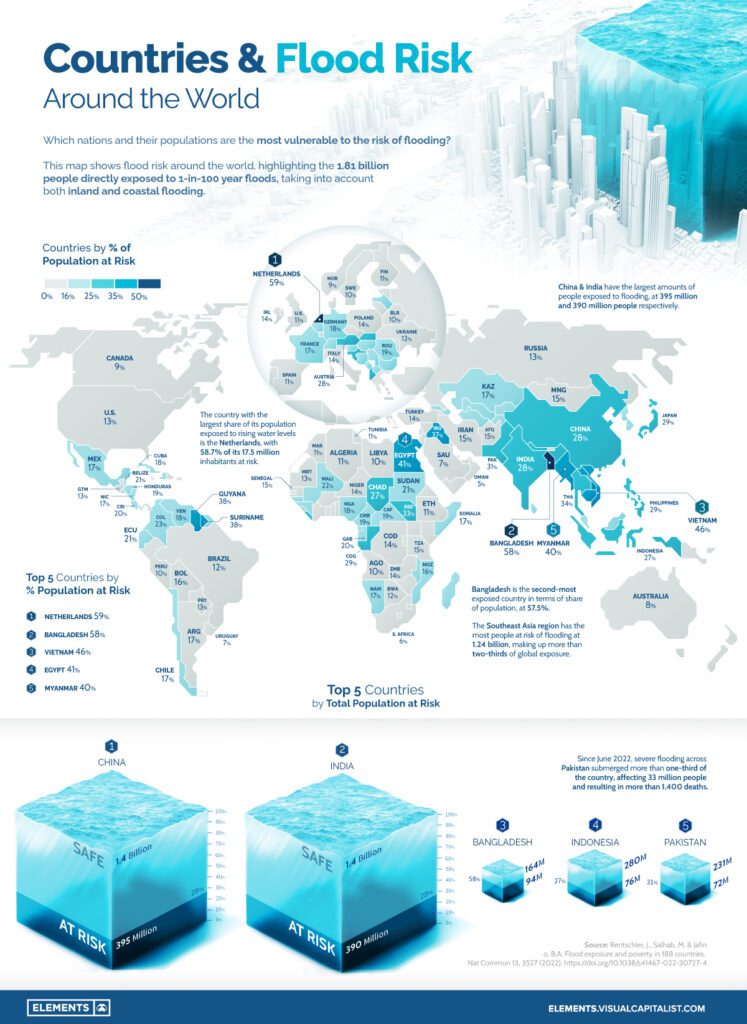By Shahabuddin Amerudin

The above figure shows the risk of flooding mapped around the world (Conte, 2022). The study uses data from Nature to map flood risks around the world and identifies countries and populations vulnerable to the risk of flooding (Rentschler et. al, 2022). The methodology includes both inland and coastal flooding risks. The Netherlands and Bangladesh have more than half of their population at risk due to flooding, followed by Vietnam, Egypt, and Myanmar. The Southeast Asia region makes up more than two-thirds of the global population exposed to flooding risk. China and India account for the highest absolute number of people at risk of rising water levels. Pakistan is particularly vulnerable to floods, with 31% of its population (72 million people) at risk of flooding. Flooding is already affecting countries like Pakistan, and the rising human toll is a major concern. Floods also bring with them massive economic costs, and the forecasted water risk caused by floods, droughts, and storms could eat up $5.6 trillion of global GDP by 2050.
Rentschler et. al (2022) reveals that coastal and riverine countries with flatlands are the most vulnerable to the risk of flooding. It highlights the need for these countries to prepare and develop effective flood management plans to mitigate the impact of flooding. Countries like Bangladesh have already been developing innovative solutions like floating hospitals, schools, and homes, to cope with the increased risk of flooding. Such solutions could be adopted by other countries to deal with the risks associated with flooding.
Conte (2022) emphasizes the need for urgent action to address the increasing risk of flooding. The rising human toll and the massive economic costs caused by flooding highlight the urgency of developing effective flood management plans. Governments and policymakers need to prioritize climate action and allocate sufficient resources to manage the risks associated with flooding. Such measures would require international cooperation, particularly in developing countries that lack the necessary resources and technology to deal with the impact of flooding.
In conclusion, Conte (2022) presents an analysis of the risk of flooding mapped around the world. It highlights the countries and populations most vulnerable to flooding, the impact of flooding on human life and the economy, and the urgent need for action to address the issue. The study calls for innovative solutions, international cooperation, and sufficient resources to develop effective flood management plans to mitigate the risks associated with flooding.
References:
Conte, N. (2022). Mapped: Countries with the Highest Flood Risk. Retrieved from: https://elements.visualcapitalist.com/mapped-countries-with-the-highest-flood-risk/
Rentschler, J., Salhab, M. & Jafino, B.A. Flood exposure and poverty in 188 countries. Nat Commun 13, 3527 (2022). https://doi.org/10.1038/s41467-022-30727-4
Suggestion for Citation: Amerudin, S. (2023). Mapping Flood Risk Around the World: Which Countries and Populations are Most Vulnerable? [Online] Available at: https://people.utm.my/shahabuddin/?p=6352 (Accessed: 15 April 2023).

